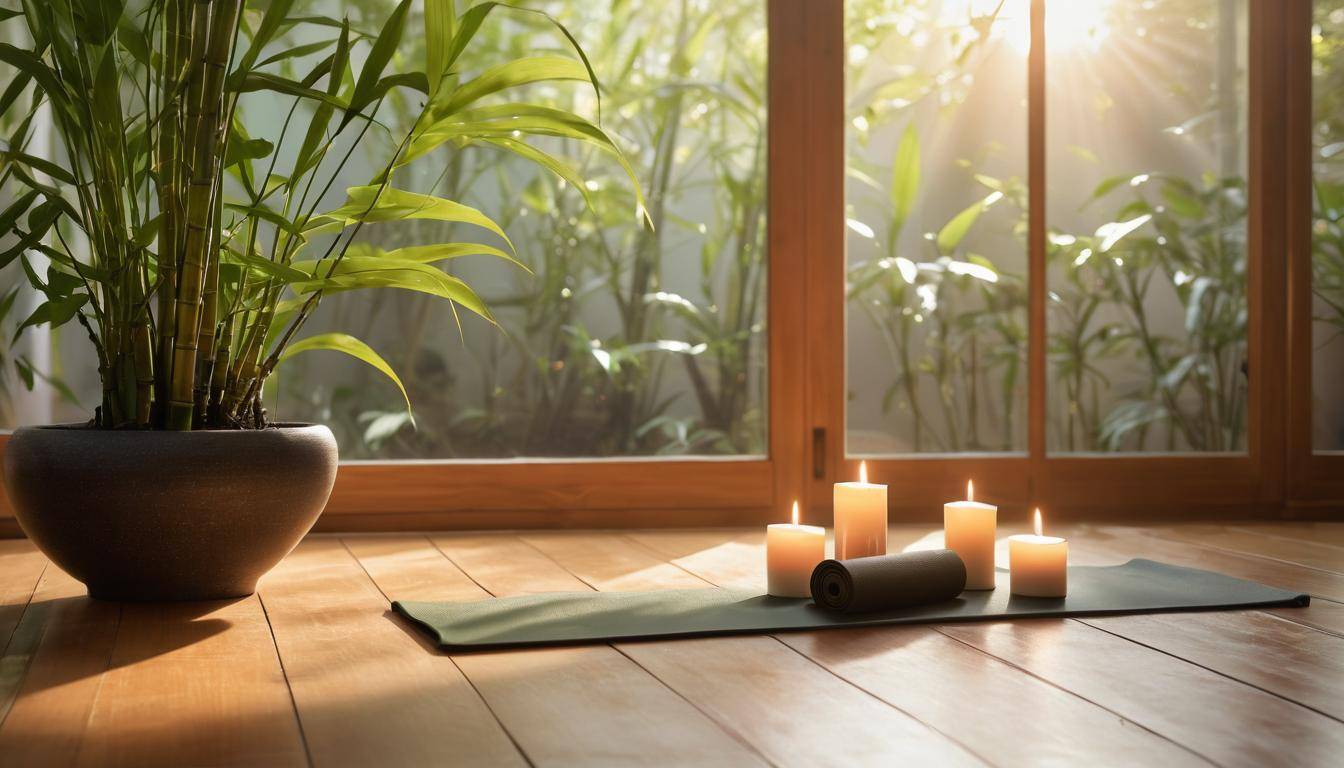Many of us know the heavy toll that chronic stress and anxiety can take on our daily lives—from sleepless nights to moments when focusing at work feels impossible. The good news? Mindfulness offers a powerful solution by helping you break free from this persistent cycle of worry. Research shows that practicing mindfulness can improve symptoms of anxiety and boost overall well-being.
In crafting this guide, we’ve gathered expert insights and examined scientific studies to bring you effective mindfulness techniques that fit seamlessly into a busy schedule. Imagine taking just a few minutes each day to practice mindful breathing or gentle meditation—simple actions with profound effects. While the idea might seem daunting at first, remember that even small, consistent efforts can lead to significant changes in managing your stress and enhancing your peace of mind.
Mindfulness can be employed for stress management by cultivating present-moment awareness, which enhances emotional regulation and resilience in stressful situations. Techniques such as mindful breathing, self-compassion, and engaging in genuine connections with others significantly contribute to reducing stress levels and improving overall well-being.

Techniques for Mindfulness in Stress Management
Mindfulness is more than just a buzzword—it’s a powerful tool for transforming how we handle stress. Starting with Meditation, this practice can serve as your anchor. Imagine settling into a cozy corner of your home, surrounded by soft cushions; you take a deep breath, close your eyes, and simply observe your breathing. If your thoughts meander to tomorrow’s worries or yesterday’s missteps, gently redirect your focus back to the inhales and exhales. The key here is consistency; even a mere 5 to 10 minutes daily can yield substantial benefits over time. A study from Johns Hopkins University highlighted that dedicating just 30 minutes to meditation each day could remarkably improve symptoms of anxiety and depression, shedding light on its potential impact.
Transitioning into another technique, the Body Scan offers an excellent way to reconnect with our physical presence. Picture yourself lying down comfortably, perhaps on a yoga mat or your bed, closing your eyes gently. By consciously directing your attention from your toes upwards, you can progressively relax each body part. This isn’t merely about relaxation; as you focus on areas of tension, you’ve taken steps towards understanding your body’s response to stress. It’s vital to approach this with patience—acknowledging sensations without judgment allows us to embrace our feelings more fully.
Embracing these techniques fosters an intimate relationship with oneself. Another practice that brings this connection to light is Loving-Kindness Meditation.
In this method, visualize a serene image of yourself at peace; then extend those warm feelings outwardly—envelope family members, friends, and eventually all living beings in waves of compassion and goodwill. Research from Stanford University indicates that engaging in Loving-Kindness Meditation can elevate positive emotions like joy and gratitude, creating ripples of positivity within and around you. In times of stress, invoking these feelings not only enhances your emotional state but also promotes resilience against the hurdles life throws your way.
Integrating these mindfulness techniques into daily life may take time and practice, but each step toward consistency enriches your journey toward stress management. Small moments dedicated to mindfulness—whether through meditation or loving-kindness visualizations—can significantly shift how you respond to stressors.
As we explore further, we will look closely at specific techniques that emphasize controlled breathing as a pathway to calmness and clarity during stressful moments.
Mindful Breathing Exercises
Mindful breathing is far more than just a technique; it’s a fundamental practice that reorients your mind and body towards peace. One of the simplest yet most effective methods is Diaphragmatic Breathing. When you breathe deeply through your nose, allowing your diaphragm to expand rather than merely filling your chest with air, you’re engaging in a process that can significantly lower levels of cortisol—your body’s main stress hormone.
Focusing on this type of breath allows you to drop into a state of relaxation, restoring balance and calmness amid chaos. You might even feel a wave of tranquility wash over you after just a few minutes.
A study published in the Journal of Clinical Psychology found that participants practicing diaphragmatic breathing reported a 40% reduction in anxiety levels after eight weeks.
As we explore various techniques, an equally compelling method is Box Breathing.
This fascinating technique involves inhaling for four counts, holding for four counts, exhaling for four counts, and then holding again for four counts. It serves as a simple yet powerful way to regulate your breath and clear your mind. When practiced regularly, box breathing acts almost like a reset button for your nervous system; however, some individuals may find it less effective due to personal preferences or specific anxieties.
It’s essential to listen to your own body and intuition—after all, mindfulness is about connecting deeply with what feels right for you. So if box breathing doesn’t work, that’s perfectly acceptable.
Following that line of thought, another enlightening exercise you can consider is Alternate Nostril Breathing.
This technique involves closing your right nostril with your thumb while inhaling through the left, then switching by closing the left nostril with a finger and exhaling through the right. This balanced approach harmonizes the two hemispheres of the brain, which often leads to increased emotional stability and calmness. Many practitioners swear by it, suggesting it has profound softening effects on both their mental state and overall well-being.
Much like any other practice, consistency is vital; try to incorporate it into your daily routine to fully appreciate its benefits.
With these actionable breathing exercises in hand, it’s equally important to recognize how these practices can foster a greater sense of well-being and stability over time.
Benefits of Mindfulness for Stress Reduction

Mindfulness offers a host of benefits that go beyond just relaxation. One significant advantage is the reduction of anxiety. A study from the University of Massachusetts Medical School revealed that participants who engaged in an eight-week mindfulness program reported a reduction in anxiety levels by up to 58%. This finding emphasizes that through mindfulness techniques, such as meditation and focused breathing, individuals can tap into a calmer state of mind, allowing them to manage day-to-day stressors more effectively.
In addition to lowering anxiety, another critical benefit is improved focus.
By practicing mindfulness, you train your brain to remain present, anchoring your attention to the task at hand. Anecdotal evidence from elite athletes showcases this profound impact; basketball player LeBron James, for example, attributes part of his success to enhanced concentration gained from regular mindfulness practices. As you cultivate better focus, distractions become less daunting, and productivity increases significantly.
Alongside reduced anxiety and improved focus, mindfulness also enhances emotional regulation.
Research indicates that mindfulness exercises strengthen the prefrontal cortex—the area of our brain responsible for regulating emotions and making thoughtful decisions. Engaging in mindfulness practices boosts self-awareness and self-control, helping us navigate challenging emotional landscapes more gracefully. For instance, during stressful situations, individuals with higher emotional regulation skills are less likely to react impulsively or lash out.
Each of these elements paints a clearer picture of why incorporating mindfulness into your routine is invaluable.
It’s not just about feeling calmer in moments of distress; it’s about developing a more resilient mindset overall. The beauty of mindfulness lies in its accessibility—practicing it doesn’t have to be overwhelming or time-consuming. With manageable steps and consistent practice, anyone can harness its benefits to lead a more balanced life while effectively managing stress.
Building on these insights, we now explore practical ways to seamlessly weave these mindfulness strategies into your everyday activities.
Incorporating Mindfulness into Daily Life

Mindfulness isn’t just an isolated practice; it can be a fluid part of your everyday activities, enhancing your overall experience and well-being. By incorporating mindfulness into daily routines, you transform simple tasks into opportunities for awareness and presence. This shift allows you to savor the small moments that often go unnoticed.
Mindful Eating
One powerful way to begin is through mindful eating. When you sit down for a meal, take a moment to notice the food on your plate. Instead of rushing through or multitasking—like scrolling through social media—try focusing solely on your meal. Savor each bite by observing its texture, flavor, and aroma. Imagine how the colors blend harmoniously on your plate; this enhances appreciation and can prevent overeating while helping establish a healthier relationship with food.
It’s amazing how slowing down during meals can bring joy back into eating—a stark contrast to hurried dinners filled with distractions that often lead us to eat mindlessly.
Mindful Walking
Another excellent opportunity for mindfulness lies in walking. The next time you step outside, pay close attention to each movement you make. Notice the sensation of your feet touching the ground, the way your legs move rhythmically, and even the feeling of the air on your skin. Each step becomes a mindful moment which serves as a form of moving meditation, turning a mundane activity—like walking from your car to the office—into a peaceful practice that clears your mind and connects you with your body.
Engaging with your surroundings while walking—hearing birds chirping or feeling the warmth of the sun—anchors you in the present moment, creating an enriching experience.
Mindful Listening
Lastly, consider mindful listening in conversations. Often, we listen to respond rather than to understand; however, by fully engaging with the speaker without preoccupied thoughts about our replies, we cultivate deeper connections. Challenge yourself to listen intently; notice their tone of voice, observe their body language, and truly absorb their words without interruption. This practice enhances communication and fosters closer relationships while simultaneously reducing stress triggered by misunderstandings.
Many people have shared how embracing this approach has significantly enriched their interpersonal skills and lowered their anxiety during interactions.
While these practices may seem straightforward, obstacles will inevitably arise as old habits are hard to break. Addressing these challenges thoughtfully can open up new pathways for enriching experiences and greater mental clarity in daily life.
Overcoming Obstacles to Mindfulness
A common barrier people encounter while practicing mindfulness is the feeling of limited time. It’s often said that “I don’t have time” to sit and meditate, but this mindset can be transformed. Instead of viewing it as a separate task, integrate mindfulness into your daily routine.
For instance, you can dedicate a few minutes to focus on your breath while commuting or engage in mindful eating during lunch breaks. When you incorporate these practices into moments you already experience, such as waiting for coffee to brew or sitting in traffic, suddenly those minutes add up, making mindfulness an effortless part of your day.
Moving beyond time constraints, another significant challenge arises from intrusive thoughts—the unexpected visitors in our minds that can disturb our focus.
Common Obstacles
It’s normal for thoughts to wander during meditation or mindfulness exercises. Instead of fighting against this natural occurrence, embracing these moments with non-judgmental acceptance can be liberating. If you notice your mind drifting toward worries or plans, gently acknowledge the thought and bring your awareness back to your breath.
Remember, this isn’t about achieving a blank mind; it’s about developing a kind of awareness that allows thoughts to come and go without fixation.
While recognizing these challenges, one might feel disheartened by the lack of immediate results, leading to frustration or abandonment of the practice altogether.
Solutions
Here’s where patience becomes vital. Mindfulness is a journey, not a destination. Understand that like any skill, the benefits unfold over time and require consistent practice.
Consider keeping a journal to track small changes—a moment when you felt less stress during a confrontation or when you responded more calmly during an overwhelming situation. This record will serve as a gentle reminder that growth happens gradually and may help reaffirm your dedication to the practice.
By tackling these common obstacles head-on and adjusting your approach, mindfulness can become an integral part of your everyday life, preparing you for even more techniques that can further enhance its effectiveness.
Practical Tips for Sustaining Mindfulness Practices
To truly embed mindfulness into your routine, creating a foundation for it to flourish is essential. One of the simplest and most effective ways to achieve this is by establishing a consistent routine. This doesn’t mean you need to block out hours every day; even dedicating as little as 5-10 minutes at specific times can significantly impact your overall well-being.
Whether it’s sitting quietly with your thoughts over morning coffee or practicing mindful breathing at lunch, these small snippets of time can transform into a powerful mindfulness habit.
As you carve out those moments, consider using technology to support your practice. Numerous apps, like Headspace and Calm, not only provide guided sessions but also include reminder features that gently nudge you when it’s time for mindfulness. Such tools can be invaluable for maintaining the habit as they help eliminate excuses and make it easier to stay on track. For more resources tailored to mindful living, our website Archie Foundation Home offers an array of helpful materials.
Another significant avenue for sustaining mindfulness is connecting with others who share your interest in the practice.
Joining community groups or engaging with online forums can foster a sense of camaraderie and provide vital support and motivation as you journey through mindfulness together. For example, the Mindful Schools alumni network hosts regular meet-ups where individuals can share experiences, challenges, and triumphs, creating a nurturing environment that enhances personal growth.
To underscore the value of technology in your mindfulness journey, here’s a quick comparison of popular mindfulness apps:
| App | Cost | Features |
|---|---|---|
| Headspace | $12.99/month | Guided Sessions, Reminders |
| Calm | $14.99/month | Sleep Stories, Breathing Exercises |
| Insight Timer | Free | Community Groups, Timed Meditations |
Implementing these practical tips should make your journey into mindfulness smoother and more sustainable; however, remember that maintaining a practice is ultimately a unique experience tailored to each individual’s needs and circumstances.
With dedication and the right tools at your disposal, you can cultivate mindfulness that leads to reduced anxiety and improved overall well-being. Start today to embrace a transformative lifestyle.
